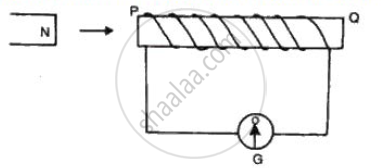Advertisements
Advertisements
प्रश्न
A potential difference of 6 V is applied across a 3 Ω resistor. What is the current flowinq throuqh the circuit?
उत्तर
Let I be the current flowing through it.
Given, potential difference, V 6 volt and Resistance, R = 3 Ω
AIC to Ohm's law,
I= `"V"/"R" = 6/3` = 2 A
APPEARS IN
संबंधित प्रश्न
An electric lamp is labelled 12 V, 36 W. This indicates that it should be used with a 1 V supply. What other information does the label provide?
A bulb marked 12 V, 24 W operated on a 12 volt battery for 20 minutes. Calculate:
(i) the current flowing through it, and
(ii) the energy consumed
The diagram shows a coil connected to a center zero galvanometerG . The galvanometer shows a deflect ion to the right when the north pole N of a powerful magnet is moved to the right as shown .

(i) Explain, why the defelct ion occurs in the galvanometer.
(ii ) State whether th e current in the coil is cl ockwise or anticl ockwise
when viewed from the end P.
(iii ) State th e observation in G when the coil is moved away from north
pole N of the magnet keeping the magnet stationary.
(iv)State the observation in G when both the coil and the magnet are
moved to right at th e same speed .
Name two common material used for heating elements.
The electric bulbs used these days have a coil-coiled filament. State its reason.
Three 250 W heaters are connected in parallel to a 100 V supply, Calculate the resistance of each heater.
A family uses a light bulb of 100W, a fan of 100W, and a heater of 1000W, each for 8 hours a day. If the cost of electricity is Rs. 2 per unit, what is the expenditure to the family per day, on electricity?
A electric bulb is rate 220 V, 60 W. its electric cell resistance is nearly
